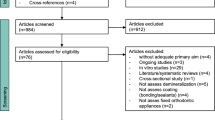Abstract
Design
Randomised controlled trial.
Intervention
Children with at least two sound permanent first molars and the presence of at least one sound distal surface of adjacent second primary molar were eligible. Children were randomised into three groups. In group one first permanent molars were sealed with a high-viscosity glass ionomer cement (GIC group; n = 926), group two received a resin-based fluoride containing sealant (RBF group; n = 923) and group three a resin-based sealant without fluoride (RB group; n = 927). Two examiners blind to group allocation conducted examinations at 30 months. Sealant retention and caries at D1-D3 levels was assessed. Bitewing radiographs were taken.
Outcome measure
Caries prevalence and incidence rate ratios were calculated.
Results
Two thousand seven hundred and seventy-six children were enrolled; the number of dropouts were similar in each group (GIC group; n = 75), (RBF group; n = 67), (RB group; n = 77). The prevalence of affected surfaces was significantly lower in the GIC (p = .03) and FRB groups (p = .04). Fewer new caries developed on the distal surfaces of the second primary molars in the GIC group than in the other two groups. Incidence rate ratios (IRRs) were: 0.70 (95% CI: 0.50, 0.68; p < .01) for GIC vs. RB; 0.89 (95% CI: 0.89, 1.28; p = .10) for GIC vs. FRB and 0.79 (95% CI: 0.53, 1.04; p = .005) for FRB vs RB. Partial sealant loss was higher in the GIC group (76 molars; 2.95%), compared with FRB (52 molars; 1.41%), RB group (50 molars;1.35%).
Conclusions
Fluoride-releasing sealants (high-viscosity GIC and fluoride RB) were demonstrated to provide protection against caries on the distal surface of second primary molars. This preventive strategy might contribute to maintaining the integrity of the mesial surfaces of the first permanent molars.
Similar content being viewed by others
Commentary
The effectiveness of pit and fissure sealants in the protection of occlusal caries has been established from previously published systematic reviews.1,2 Nevertheless, the effect of fluoridated forms of fissure sealants on the adjacent teeth has not been measured. This randomised clinical trial addresses an interesting question: ‘Is there a cariostatic effect of fluoridated fissure sealants on the smooth surfaces of neighbouring teeth?’ If the answer is positive, then fluoridated fissure sealants could be used to decrease risk of decay on mesial surfaces of erupting first permanent molars. Hence an added benefit is to be expected when using such sealants in preschool children.
A total of 2776 school children aged from six to seven years participated in this trial, of which 2557 children completed a 30-month follow-up. They were randomly assigned to three groups according to the type of fissure sealant used; high viscosity glass ionomer cement (GIC), fluoride resin based (FRB) and resin based (RB). Permuted block randomisation was utilised. Blocks of two or four with random variation of blocking numbers resulted in three groups with fairly similar baseline characteristics. Although the method of randomisation was clearly described, the method of allocation concealment and implementation of randomisation were not stated. On the level of reporting clinical procedures, the examiners were calibrated with resultant high intra- and inter-examiner reliability. This would ensure consistency and coherence during examination. Meanwhile, the steps for placing each type of fissure sealant were not mentioned with specific details to allow replication.
Regarding data analysis and results, some errors in reporting numbers exists even after the authors have published a corrigendum delineating typos in their confidence intervals. An example from the corrigendum is ‘IRR was 0.89 (95% CI: 0.89, 1.28; p = .10) between GIC and fluoride-RB’, where it is mathematically not possible to find the point estimate equals one of the limits of the confidence interval. In addition, the researchers didn't supply information regarding sample size calculation, thus the exact power of the study (its ability to detect differences between fissure sealants used) can't be estimated.
Finally, the authors concluded that GIC and RBF sealants provide added protection to the distal surface of neighbouring second primary molars. This interpretation of results could be exaggerated. The percentage of new decayed/filled distal surfaces of second primary molars after a 30 month follow-up was 12.17, 13.06 and 16.38% for GIC, FRB, and RB respectively. Although this result was statistically significant (p = 0.04), the difference in caries incidence is modest, which might not indicate a true clinical significance to some practitioners.
References
Ahovuo-Saloranta A, Forss H, Walsh T, et al. Sealants for preventing dental decay in the permanent teeth. Cochrane Database Syst Rev 2013; 3: CD 001830.
Hiiri A, Ahovuo-Saloranta A, Nordblad A, Makela M . Pit and fissure sealants versus fluoride varnishes for preventing dental decay in children and adolescents. Cochrane Database Syst Rev 2010; 3: CD 003067.
Wiegand A, Buchalla W, Attin T . Review on fluoride-releasing restorative materials--fluoride release and uptake characteristics, antibacterial activity and influence on caries formation. Dent Mater 2007; 23: 343–362.
Author information
Authors and Affiliations
Additional information
Address for correspondence: G Campus, WHO Collaborating Centre of Milan for Epidemiology and Community Dentistry, University of Milan, San Paolo Hospital, Milan, Italy Department of Surgery, Microsurgery, and Medical Science, School of Dentistry, University of Sassari, Italy. E-mail: gcampus@uniss.it
Cagetti MG, Carta G, Cocco F, Sale S, Congiu G, Mura A, Strohmenger L, Lingström P, Campus G Italian Experimental Group on Oral Health. Effect of Fluoridated Sealants on Adjacent Tooth Surfaces: A 30-mo Randomized Clinical Trial. J Dent Res 2014; 93: 59S–65S.
Rights and permissions
About this article
Cite this article
Elkhadem, A., Wanees, S. Fluoride releasing sealants may possess minimal cariostatic effect on adjacent surfaces. Evid Based Dent 16, 12 (2015). https://doi.org/10.1038/sj.ebd.6401075
Published:
Issue Date:
DOI: https://doi.org/10.1038/sj.ebd.6401075



